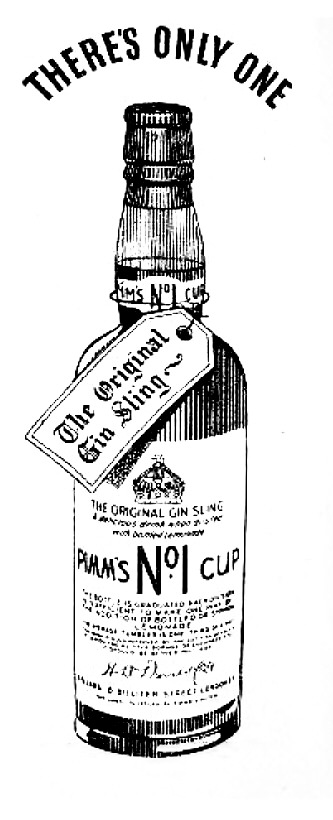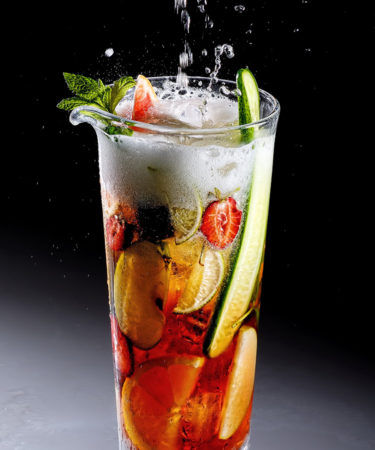A fruity gin-based spirit, Pimm’s — or Pimm’s No. 1 Cup — is a liqueur that’s at once somewhat familiar and somewhat mysterious the world over. There are probably a lot more than 11 things you don’t know about Pimm’s, since many folks outside of the U.K. don’t know a ton about Pimm’s in the first place. (Well, some of us do, but we’ll get to that.)
And whether you’re new to Pimm’s or the sweet-spiced herbal concoction is a staple on your bar, when warm weather hits, there really is nothing more appropriate than kicking back on a stoop or hammock, or wherever you do your kicking back, and sipping a tall, cool Pimm’s Cup. Read on for 11 things to know about Pimm’s.
There Was A Dude Named Pimm.
Just like there is a dude named Charles Walgreen and a town called Prosecco, there was a dude named Pimm. James Pimm ran an oyster bar in mid 19th Century London, where he created the liquid in question. The bar gained so much popularity following the creation of the cocktail that it became an English chain.
Pimm’s Was Marketed In The 19th Century As A Health Drink.
Pimm’s was the 1800’s equivalent of green juice or Kombucha. James Pimm sold the gin-based, herbal fruity liqueur as a “health tonic” and a “digestive aid.” Just imagine your yogi friends knocking one back in the name of wellness.
Pimm’s Contains Anti-malaria Medicine.
As if we needed any more convincing that Pimm’s is the perfect summer drink, it’s a mosquito’s worst nightmare. Like tonic water, Pimm’s contains a chemical called quinine, which is commonly used to treat malaria.
It Has More To Do With Oysters Than You’d Think.
Yes, Pimm’s tastes like fruit and spice and no, it has nothing remotely to do with bivalves. But Pimm’s was originally blended to aid in the digestion of oysters.
The “Cup” Aspect Of Pimm’s Is Very Appropriately Literal.
The No. 1 in “Pimm’s No. 1 Cup” isn’t shameless self promotion (“we’re number one, drink our stuff!”). Pimm actually tried other formulas, based on other spirits like rum and brandy (and even absinthe), but apparently hit it out of the park the first time with the gin liqueur, hence the No. 1 Cup. In 2005, most of the less successful Pimm’s formulas were phased out, with just No. 6 (made with vodka) sticking around in addition to No. 1.
When Wimbledon Hits, So Does A Temporary Craze With Pimm’s.
Pimm’s is basically the official beverage of the tennis tournament. In 2016, fans consumed 320,000 glasses of the stuff in the span of two weeks, an amount that’s just about become the standard estimate for consumption during the tourney. The tradition of imbibing Pimm’s is so tied to Wimbledon that you can even find red-and-white Pimm’s themed bars at the tournament — the first one opened up in 1971.
London Loves Its Pimm’s, But So Does Louisiana.
It’s not entirely clear how the Pimm’s tradition made its way to New Orleans, but the locals have their own Pimm’s obsession. About a hundred years after Pimm’s was invented, it somehow crossed an ocean and landed at The Napoleon House Bar in 1940. However it got there, the light and fruity drink does make a lot of sense for the New Orleans climate — more sense than the delicious but high ABV Sazerac.
London And New Orleans Serve It Differently.
In England, Pimm’s is typically made with sparkling lemonade or even lemon lime soda, then garnished with a cottage garden’s worth of summer fruit and fresh herbs. In NOLA, the most popular recipe has Pimm’s, lemonade, a splash of lemon lime soda, and cucumber. (Ginger ale is also a popular mixer.) For some reason, no heated rivalry exists about this — possibly because everyone’s too relaxed sippin’ on Pimm’s.

Speaking Of Recipes, You Can Muck With A Classic.
Or we did, anyway. Even though per this old timey advertisement, “there is only one,” you can do a lot more than one recipe with Pimm’s, as it lends itself to a variety of flavors. (That’s kind of the beauty of creating an herbaceous, fruity liqueur—lots to play with there.) We had a real Englishwoman and friend of the site share her authentic Pimm’s Cup, and then, being Americans, we lovingly bastardized it (even upped the ABV with some bourbon). All of it tasted like summertime delight.
We’re Not The Only Ones Who Like To Play With Pimm’s.
Turns out professional bartenders have been tweaking their Pimm’s Cups for years, adding things like tequila, red wine, and different garnishes (not all in the same cup).
Even The Queen Of England Lets Loose With Some Pimm’s.
Should we be surprised? The drink is quintessentially British (though it’s not typically consumed with tea and crumpets.) Apparently, Queen Elizabeth II has a taste for Pimm’s, and occasionally orders it to Buckingham Palace. (Rumor has it that she’s also a Bacardi fan…)
